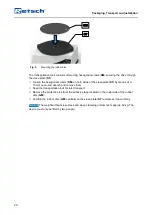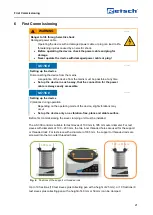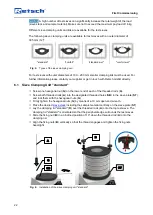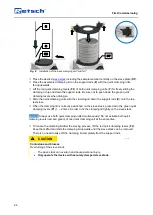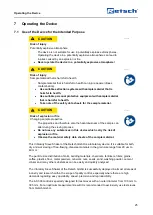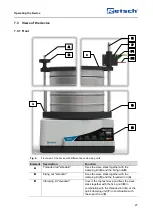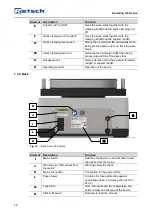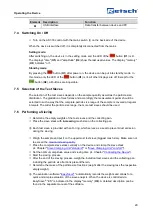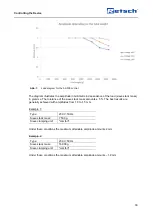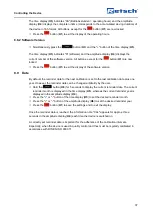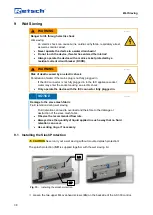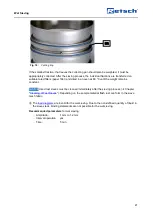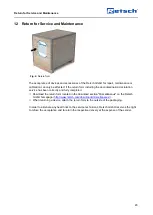
Controlling the Device
34
Pos : 17.16 / 0005 R ET SCH/ 0030 Übersc hrift en/1.1 Übersc hriften/ 11 Z eit @ 14 \mod_1456309916004_9. docx @ 99356 @ 2 @ 1
8.4 Time
Pos : 17.17 / 0005 R ET SCH/ 0005 Bedienungsanl eitungen/ AS 200 / AS 300 s erie/Modul e/ 5025 Z eit AS 200 / AS 300 Seri e B @ 14\m od_1456310197970_9.docx @ 99392 @ @ 1
Fig. 12:
Time setting for continuous operation (left) or with a process time (right)
The AS 300 control can be operated either in continuous operation or for a certain time between
1 and 99 minutes. When the device is switched on, the last used setting is displayed.
Press the "+" or "-" button of the time display (
H5
) to set the desired process time.
Press and hold the "+" or "-" button to extend or reduce the process time in steps of ten
minutes, respectively.
To change to the continuous operation, fall below the duration of 1 min by pressing the "-"
button, or exceed the duration of 99 min by pressing the "+" button. The time display (
H5
)
now indicates "
−
−
".
The process time can also be changed during operation by pressing the "+" or "-" button.
Pos : 17.18 / 0005 R ET SCH/ 0030 Übersc hrift en/1.1 Übersc hriften/ 11 O ptimi erung v on Zeit und Am plit ude @ 14\mod_1456312176802_9. docx @ 99495 @ 2 @ 1
8.5 Optimisation of Time and Amplitude
Pos : 17.19 / 0005 R ET SCH/ 0005 Bedienungsanl eitungen/ AS 200 / AS 300 s erie/Modul e/ 5026 Optimi erung v on Zeit und Am plit ude AS 200 / AS 300 Seri e B @ 24\m od_1502883040185_9. doc x @ 212599 @ @ 1
The settings of the optimum sieving time and amplitude depend on the sample material. These
settings have a substantial influence on the measurement result. Generally, national and
international standards, internal regulations and standards provide detailed information on
product-specific sieve analyses and the associated sieving parameters. If such basic
information cannot be obtained, the sieving time and amplitude must be determined
experimentally.
With the AS 300 control the amplitude is defined as the total lifting height (
SH
) of the test sieve.
For example, with a set amplitude of 1.2 mm, the test sieve is displaced in the range of -0.6 mm
and +0.6 mm around the zero point (= stationary sieve plate (
ST
)).
An
optimum amplitude
has been found, when a state of statistical resonance is being reached
during the sieving process. Then, the particles have the biggest probability of passing, as the
throw time of a particle corresponds to the oscillation period of the test sieve. In this case, the
particle (
PA1
) will be moved with a different orientation to a different mesh every time the test
sieve (
SH
) lifts. At too low amplitudes, the particles (
PA2
) do not lift off high enough from the
sieve mesh fabric, and are therefore not able to orientate freely and move freely over the sieve
mesh fabric. At too high amplitudes, the particles (
PA3
) are thrown up very high, and thus have
fewer opportunities to compare themselves with the sieve meshes. The best results are
generally achieved with amplitudes from 1.0 to 1.5 mm.
The
optimum sieving time
is in accordance with DIN 66165 achieved, if less than 0.1 % of the
feed quantity passes the test sieve after one minute of sieving duration. In practice, the
individual test sieves are weighed after the sieving process including the respective particle size
fraction. Then, the sieve stack is sieved again for one minute. The weights of the individual test
sieves of the second weighing must not differ substantially from those of the first weighing.

